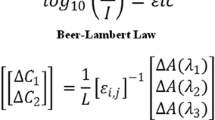Abstract
Increased intracranial pressure (ICP) is known to affect the levels of distortion product otoacoustic emissions (DPOAEs) in a frequency-specific manner. DPOAEs might, therefore, be used for monitoring the ICP non-invasively. Hypoxia can also cause alterations of DPOAE levels, which can be distinguished from ICP-related changes only, when their characteristics, in particular frequency specificity, are known in detail. DPOAEs at f 2 = 2, 4, 8, 12 and 16 kHz and oxygen saturation (SaO2) were continuously monitored in nine spontaneously breathing guinea pigs, anaesthetized by i.m. administration of midazolam, medetomidin and fentanyl, during the respiration of a gas mixture of N2O and O2 containing either 30% O2 or 13% O2. Fourteen hypoxic intervals in eight animals were included into final data analysis. Characteristic hypoxic level alterations with a level decrease and a remarkable level destabilization during hypoxia, and a pronounced reversible level decrease after reoxygenation were observed at the frequencies of 4, 8 and 16 kHz. At 2 and 12 kHz, the only reproducible effect of hypoxia was an increased fluctuation of the DPOAE level, which was significantly less pronounced compared with the other frequencies (P < 0.05 for 12 vs. 16 and 8 kHz and for 2 vs. 16 kHz). DPOAE level alterations due to hypoxia depend on the frequency in guinea pigs. Studies in human are warranted to improve non-invasive ICP monitoring with DPOAE by the detection of hypoxia-related changes.





Similar content being viewed by others
References
Czosnyka M, Pickard JD (2004) Monitoring and interpretation of intracranial pressure. J Neurol Neurosurg Psychiatry 75(6):813–821
Steiner LA, Andrews PJ (2006) Monitoring the injured brain: ICP and CBF. Br J Anaesth 97(1):26–38
Buki B, Chomicki A, Dordain M, Lemaire JJ, Wit HP, Chazal J, Avan P (2000) Middle-ear influence on otoacoustic emissions. II Contributions of posture and intracranial pressure. Hear Res 140(1–2):202–211
Frank AM, Alexiou C, Hulin P, Janssen T, Arnold W, Trappe AE (2000) Non-invasive measurement of intracranial pressure changes by otoacoustic emissions (OAEs): a report of preliminary data. Zentralbl Neurochir 61(4):177–180
Voss SE, Horton NJ, Tabucchi TH, Folowosele FO, Shera CA (2006) Posture-induced changes in distortion-product otoacoustic emissions and the potential for noninvasive monitoring of changes in intracranial pressure. Neurocrit Care 4(3):251–257
Plinkert PK, Ptok M (1994) Changes in transitory evoked otoacoustic emissions and acoustic distortion products in disorders of eustachian tube ventilation. HNO 42(7):434–440
Cazals Y (2000) Auditory sensori-neural alterations induced by salicylate. Prog Neurobiol 62(6):583–631
Mills DM, Rubel EW (1994) Variation of distortion product otoacoustic emissions with furosemide injection. Hear Res 77(1–2):183–199
Shi Y, Martin WH (1997) ABR and DPOAE detection of cochlear damage by gentamicin. J Basic Clin Physiol Pharmacol 8(3):141–155
Wake M, Anderson J, Takeno S, Mount RJ, Harrison RV (1996) Otoacoustic emission amplification after inner hair cell damage. Acta Otolaryngol 116(3):374–381
Suckfull M, Winkler G, Thein E, Raab S, Schorn K, Mees K (1999) Changes in serum osmolarity influence the function of outer hair cells. Acta Otolaryngol 119(3):316–321
Olzowy B, von Gleichenstein G, Canis M, Plesnila N, Mees K (2008) Complex level alterations of the 2f (1)-f (2) distortion product due to hypoxia in the guinea pig. Eur Arch Otorhinolaryngol 265(11):1329–1333
Rebillard G, Lavigne-Rebillard M (1992) Effect of reversible hypoxia on the compared time courses of endocochlear potential and 2f1–f2 distortion products. Hear Res 62(2):142–148
Sawada S, Mori N, Mount RJ, Harrison RV (2001) Differential vulnerability of inner and outer hair cell systems to chronic mild hypoxia and glutamate ototoxicity: insights into the cause of auditory neuropathy. J Otolaryngol 30(2):106–114
Olzowy B, von Gleichenstein G, Canis M, Mees K (2008) Distortion product otoacoustic emissions for assessment of intracranial hypertension at extreme altitude? Eur J Appl Physiol 103:19–23
Frolenkov GI, Belyantseva IA, Kurc M, Mastroianni MA, Kachar B (1998) Cochlear outer hair cell electromotility can provide force for both low and high intensity distortion product otoacoustic emissions. Hear Res 126(1–2):67–74
Whitehead ML, Lonsbury-Martin BL, Martin GK (1992) Evidence for two discrete sources of 2f1–f2 distortion-product otoacoustic emission in rabbit. II Differential physiological vulnerability. J Acoust Soc Am 92(5):2662–2682
Michaelis CE, Gehr DD, Deingruber K, Arnold W, Lamm K (2004) Optimum primary tone level setting for measuring high amplitude DPOAEs in guinea pigs. Hear Res 189(1–2):58–62
Rebillard G, Klis JF, Lavigne-Rebillard M, Devaux P, Puel JL, Pujol R (1993) Changes in 2f1–f2 distortion product otoacoustic emissions following alterations of cochlear metabolism. Br J Audiol 27(2):117–121
Freeman S, Goitein K, Attias J, Furst M, Sohmer H (1995) Effect of hypoxemia and ethacrynic acid on ABR and distortion product emission thresholds. J Neurol Sci 131(1):21–29
Dallos P, Evans BN (1995) High-frequency motility of outer hair cells and the cochlear amplifier. Science 267(5206):2006–2009
Acknowledgments
We like to thank Prof. Dr. Ulrich Pohl, director of the Walter Brendel Center for Experimental Medicine, for the opportunity to make our experiments in his laboratory and to use all facilities for experimental animals. We further like to thank the keepers who took care of our laboratory animals. The investigations were supported by the Program for Research and Teaching of the Faculty of Medicine of the University of Munich (Föderprogramm für Forschung und Lehre der Medizinischen Fakultät der Ludwig Maximilians Universität München, Reg.-Nr. 403).
Conflict of interest statement
None of the authors has any conflict of interest.
Author information
Authors and Affiliations
Corresponding author
Rights and permissions
About this article
Cite this article
Olzowy, B., von Gleichenstein, G., Canis, M. et al. Level alterations of the 2f 1–f 2 distortion product due to hypoxia in the guinea pig depend on the stimulus frequency. Eur Arch Otorhinolaryngol 267, 351–355 (2010). https://doi.org/10.1007/s00405-009-1052-2
Received:
Accepted:
Published:
Issue Date:
DOI: https://doi.org/10.1007/s00405-009-1052-2




